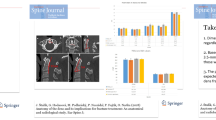Summary
The trans-condylar approach to the craniocervical junction area (CCJA) requires a more or less extensive drilling of the two first cervical joints (C0–C1 and C1–C2). The extent of drilling necessary to resect a lesion at the CCJA was analyzed from a series of 125 cases including 114 tumours and 11 non-tumoural processes treated using a lateral approach (postero-lateral or antero-lateral) over a 15-year period (1980–1995)
The extent of drilling was estimated on CT scanner axial views from the reduction of the joints surface and three groups were determined: A/less than one third B/between one third and one half, and C/more than one half. The extent of drilling was compared with the lesion location in relation to the bone limits of the CCJA: within these limits, outside them and into the bony structures. It was also analyzed with regard to pathology when separated into three groups: non-osseous tumours, osseous tumours and chordomas, and non-tumoural processes.
Only 26 cases had a significant drilling, i-e more than one third of the joint surfaces and of these, 14 were more than one half. In all these 14 cases, the bone structures were already invaded and 13 of them were, to some extent, beyond the bone limits of the CCJA. Of the 12 cases with drilling between one third and one half, 11 involved the bone structures and 1 was located inside the CCJA bone limits. Drilling of more than one third was required only in the case of bone lesions: 10 out of 23 bone tumours, all the 14 cases of chordomas, one case of rheumatoïd arthritis and one case of C1–C2 joint spondylosis. In the other cases including mostly non-osseous tumours, drilling was limited to less than one third, though a high rate of complete removal was achieved (98%). Stabilization by arthrodesis with posterior grafting (N=10) or by lateral bone grafting (N=5) was achieved in all cases involving more than one half drilling, and in one case of tuberculosis.
By adequately choosing the surgical approach, the extent of drilling can always be minimal. Extensive bone resection is only necessary when the tumour has already destroyed the joints. In that case, lateral or posterior fusion is an efficient technique.
Similar content being viewed by others
Author information
Authors and Affiliations
Rights and permissions
About this article
Cite this article
Lot, G., George, B. The Extent of Drilling in Lateral Approaches to the Cranio-Cervical Junction Area from a Series of 125 Cases. Acta Neurochir (Wien) 141, 111–118 (1999). https://doi.org/10.1007/s007010050274
Issue Date:
DOI: https://doi.org/10.1007/s007010050274




